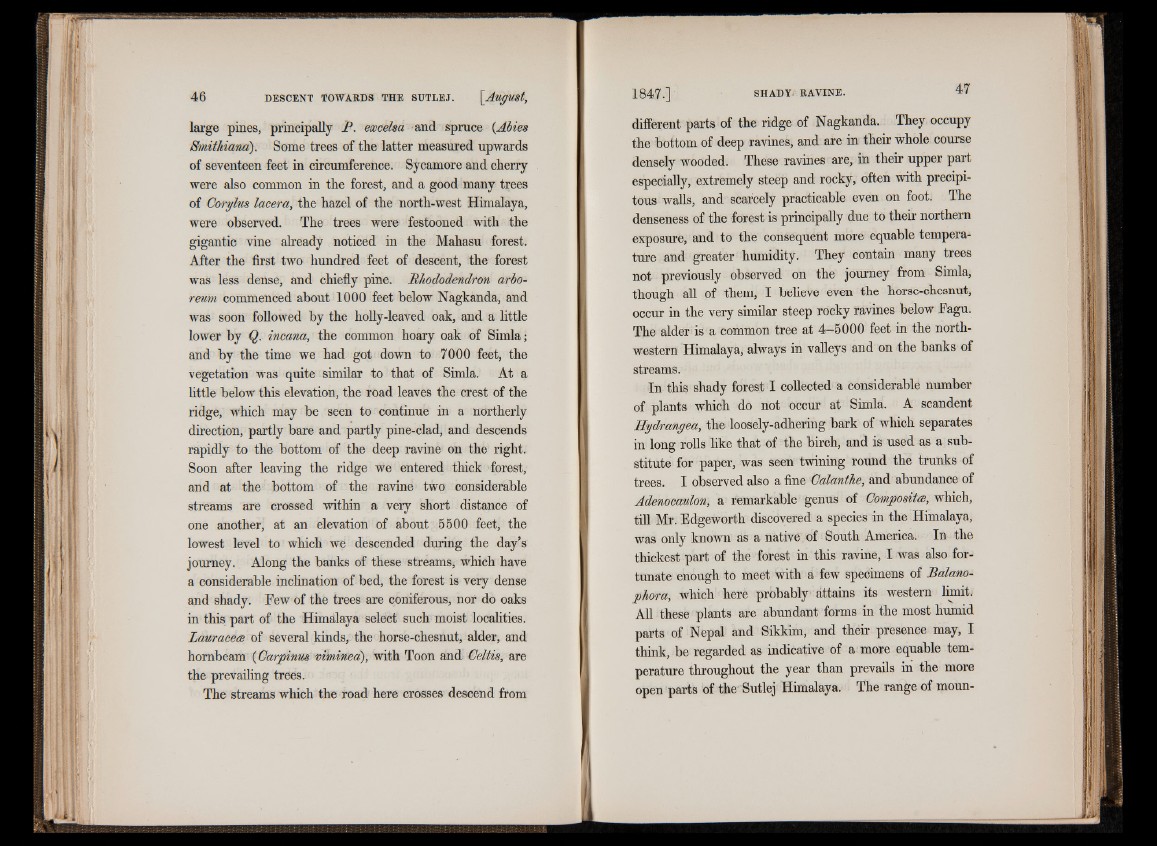
large pines, principally P. eaccelsa and spruce {Abies
Smithiana). Some trees of the latter measured upwards
of seventeen feet in circumference. Sycamore and cherry
were also common in the forest, and a good many trees
of Corylus lacera, the hazel of the north-west Himalaya,
were observed. The trees were festooned with the
gigantic vine already noticed in the Mahasu forest.
After the first two hundred feet of descent, the forest
was less dense, and chiefly pine. Rhododendron arbo-
reum commenced about 1000 feet below Nagkanda, and
was soon followed by the holly-leaved oak, and a little
lower by Q. incana, the common hoary oak of Simla;
and by the time we had got down to 7000 feet, the
vegetation was quite similar to that of Simla. At a
little below this elevation, the road leaves the crest of the
ridge, which may be seen to continue in a northerly
direction, partly bare and partly pine-clad, and descends
rapidly to the bottom of the deep ravine on the right.
Soon after leaving the ridge we entered thick forest,
and at the bottom of the ravine two considerable
streams are crossed within a very short distance of
one another, at an elevation of about 5500 feet, the
lowest level to which we descended during the day’s
journey. Along the banks of these streams, which have
a considerable inclination of bed, the forest is very dense
and shady. Few of the trees are coniferous, nor do oaks
in this part of the Himalaya select such moist localities.
lauraceee of several kinds, the horse-chesnut, alder, and
hornbeam {Carpinus vi'minea), with Toon and Celtis, are
the prevailing trees.
The streams which the road here crosses descend from
different parts of the ridge of Nagkanda. They occupy
the bottom of deep ravines, and are in their whole course
densely wooded. These ravines are, in their upper part
especially, extremely steep and rocky, often with precipitous
walls, and scarcely practicable even on foot. The
denseness of the forest is principally due to their northern
exposure, and to the consequent more equable temperature
and greater humidity. They contain many trees
not previously observed on the journey from Simla,
though all of them, I believe even the horse-chesnut,
occur in the very similar steep rocky ravines below Fagu.
The alder is a common tree at 4-5000 feet in the northwestern
Himalaya, always in valleys and on the banks of
streams.
In this shady forest I collected a considerable number
of plants which do not occur at Simla. A scandent
Hydrangea, the loosely-adhering bark of which separates
in long rolls like that of the birch, and is used as a substitute
for paper, was seen twining round the trunks of
trees. I observed also a fine Calanthe, and abundance of
Adenocaulon, a remarkable genus of Composite, which,
till Mr. Edgeworth discovered a species in the Himalaya,
was only known as a native of South America. In the
thickest part of the forest in this ravine, I was also fortunate
enough to meet with a few specimens of Balano-
phora, which here probably attains its western limit.
All these plants are abundant forms in the most humid
parts of Nepal and Sikkim, and their presence may, I
think, be regarded as indicative of a more equable temperature
throughout the year than prevails in the more
open parts of the Sutlej Himalaya. The range of moun